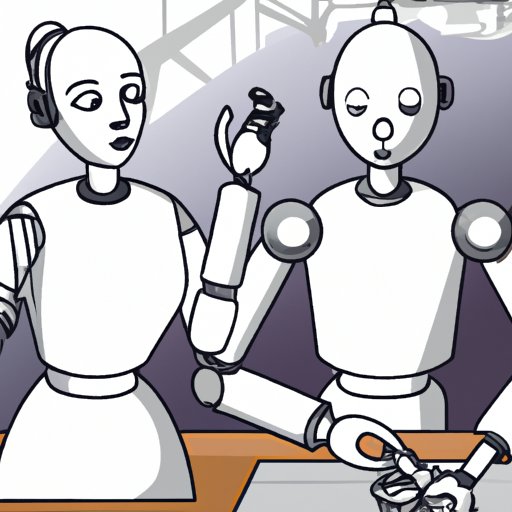Introduction
The idea of robots taking over jobs has been a topic of discussion for decades, but with the recent advances in technology, it is becoming more and more of a reality. Automation is quickly changing the workplace, and it is important to understand the implications of this shift. This article will explore the possibility of jobs being replaced by robots, provide an overview of automation and its impact on the workplace, and examine how automation is changing the workplace.

Examining How Automation is Changing the Workplace
As robots become increasingly capable and sophisticated, they are being used for a variety of tasks that were once done exclusively by humans. According to a report from the McKinsey Global Institute, “automation could displace the equivalent of up to one-third of the world’s current workforce by 2030.” This means that many jobs that were once considered safe and secure could be at risk of being replaced by machines.
When comparing human workers to robotic ones, it is clear that robots have certain advantages. They can work around the clock without needing breaks, and they don’t require wages or benefits. In addition, robots can be programmed to perform tasks with greater accuracy and speed than humans, making them more efficient and cost effective. However, there are also some drawbacks to using robotic workers, such as diminished quality of service.
Assessing the Benefits and Drawbacks of Automated Jobs
There are both benefits and drawbacks to using robotics in the workplace. On the plus side, robots can improve efficiency and help employers save money. For example, a company that employs robots to assemble products can produce more items in a shorter amount of time and with less waste. Additionally, robots can take on dangerous jobs that would otherwise be too risky for human workers, such as cleaning up hazardous materials.
However, there are also some drawbacks to using robots. One of the biggest concerns is job loss. As robots become more common in the workplace, they could replace human workers and lead to increased unemployment. Additionally, robots may not be able to provide the same level of customer service as humans, which could lead to a decrease in quality of service.
Discussing the Future of Work in a Robot-Dominated Society
As robots become more prevalent in the workplace, it is important to consider what the future of work might look like in a robot-dominated society. While it is likely that some jobs will be lost, there is also potential for unexpected job opportunities. For example, as robots take on more manual labor, new positions may open up for people who specialize in programming and maintaining robots.
In addition to creating new job opportunities, automation will also present some challenges. As robots become more advanced, they will need to be managed and maintained by skilled professionals. Additionally, companies will need to invest in training their employees to ensure they are up to date on the latest technology and able to adapt to the changing workplace.
Finally, it is important to note that while robots may be able to do certain tasks more efficiently, they will never be able to replicate the creativity and innovation of humans. Companies must recognize that robots can only do so much and that the most successful organizations will be those that are able to embrace change and use technology to their advantage.
Conclusion
The rise of automation has changed the workplace in a number of ways. Robots are becoming increasingly capable and are being used for a variety of tasks that were once done exclusively by humans. While there are some benefits to using robots, such as improved efficiency and cost savings, there are also some drawbacks, such as job losses and diminished quality of service. Looking ahead, it is important to recognize that robots will never be able to replicate the creativity and innovation of humans, and companies must be willing to embrace change and invest in training their employees in order to remain competitive in a robot-dominated society.
(Note: Is this article not meeting your expectations? Do you have knowledge or insights to share? Unlock new opportunities and expand your reach by joining our authors team. Click Registration to join us and share your expertise with our readers.)
